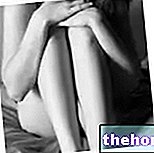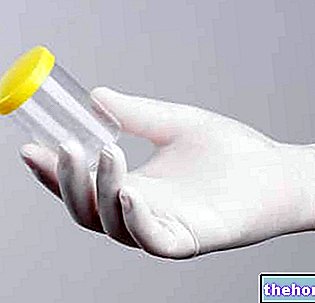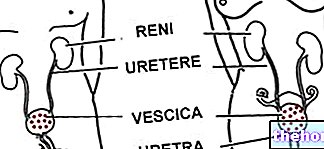Generality
Overactive bladder syndrome is a urological condition defined by a set of symptoms - such as an urgent need to urinate - that are NOT related to other conditions with similar manifestations (including bladder tumors, infections or obstructive urinary tract diseases).

What is an overactive bladder?
Overactive bladder syndrome (OAB, OverActive Bladder or more simply overactive bladder) includes a set of symptoms that includes:
- Urgency: sudden and unbearable urge to urinate, which often results in the inability to hold urine;
- Increase in urination frequency: more than 8 times over a 24-hour period;
- Urge incontinence: involuntary loss of urine immediately after feeling the urge to urinate;
- Nocturia: repeated urge to eliminate urine during the night's rest (at least twice a night);
- Distension of the abdomen.
These symptoms, considered in isolation, may coincide with those associated with other conditions affecting the bladder, including interstitial cystitis or tumors. A brief medical evaluation makes it possible to exclude these diseases and arrive, by exclusion, at the diagnosis of overactive bladder syndrome.
Although the disorder is more common among older adults, it should not be considered an inevitable consequence of the aging process. The available treatments can greatly reduce or even eliminate symptoms, helping to manage their impact on daily life.
Causes
The normal functioning of the bladder is the result of a complex interaction between neurological and psychological factors, and the "musculoskeletal and renal activity. The set of these physiological mechanisms, partly voluntary and partly involuntary, determines bladder filling and emptying. - in times and places considered appropriate - of the urine collected. Even a single problem at the various levels of this system can contribute to the onset of overactive bladder syndrome.
Involuntary contractions of the bladder. The disorder is often associated with overactivity of the detrusor muscle, which has the function of contracting during urination to cause the expulsion of urine. The abnormal and involuntary contractions of this muscle during bladder filling cause an urgent urge to urinate before the bladder has filled to normal volumes.
Several other conditions can contribute to the onset of overactive bladder symptoms, including:
- Elevated urine output, as may occur with excessive fluid intake, poor kidney function, or diabetes
- Abnormalities in the bladder, such as tumors, bladder stones or other factors that obstruct normal outflow (enlarged prostate, constipation or previous uro-gynecological surgery). In men, overactive bladder syndrome is very often related to benign prostatic hypertrophy;
- Altered sensitivity of the bladder wall;
- Weakness of the pelvic muscles, due to pregnancy and childbirth (conditions that can also stretch the sphincter sphincter to damage it and cause incontinence).
- Neurological disorders, such as Parkinson's disease, stroke and multiple sclerosis. The overactive bladder can be an expression of damage to the central nervous system, spinal cord or nerves, which can lead to the interruption of the cerebral cortex-bladder nerve pathway, along which the impulses that prevent the muscle from contracting properly travel. Trauma or iatrogenic spinal injuries can also cause alterations in the urination reflex: this is the case of herniated discs, uro-gynecological surgery and radiation exposure.
- Taking diuretic medications and excessive consumption of caffeine or alcohol can cause a rapid increase in urine output.
- Acute urinary tract infections cause symptoms similar to an overactive bladder, in that they can irritate the nerves and induce urge to urinate.
- Excess weight. Being overweight increases intra-abdominal pressure, which in the long run can strain the urethral sphincter and lead to urine loss.
- Postmenopausal estrogen deficiency: May contribute to urge urine loss. Together with the doctor, the patient can evaluate local or general estrogen therapy.
Diagnosis
If the patient continually feels a sudden and irrepressible urge to urinate, with increased urination both day and night and possible urge incontinence, the doctor may suspect that the bladder is overactive.
Diagnosis is established after excluding other relevant pathologies, such as urinary tract infections, lower urinary tract obstructions and bladder tumors. The doctor then proceeds to search for clues that could indicate the factors favoring the onset of the condition.
The diagnostic path will likely include:
- General evaluation and anamnesis;
- Physical examination, which includes physical examination of the abdomen and genitals, rectal examination in men (to evaluate the size, consistency and overall mass of the prostate) and pelvic examination in women (to evaluate atrophy, inflammation, infection);
- In man, dosage of PSA (prostate specific antigen);
- Urinalysis and urine culture: allow to exclude the presence of urinary infections, traces of blood or analytical abnormalities in the urine;
- Neurological examination: allows you to identify sensory problems or abnormal reflexes;
- Urodynamic test: evaluates the function of the bladder and its ability to empty and fill properly. If the bladder does not empty completely during urination, the residual urine can cause symptoms identical to an overactive bladder. To measure the amount of urine not passed, the doctor may proceed with an ultrasound examination of the bladder or insert a thin catheter through the bladder. "urethra to drain and measure the residual post-urination fluid still present in the bladder.
- Uroflowmetry: functional investigation that allows to measure the volume and speed of the urinary flow. The patient urinates normally into a device connected to a computer, which records the parameters of the urinary flow and converts the data into a frequency / volume graph, which highlights the variations in flow rate compared to the norm.
Other urodynamic techniques:
- Cystometry: can identify if involuntary muscle contractions occur or the bladder is unable to store urine properly;
- Urethrocystoscopy: allows you to exclude tumors and kidney stones.



























